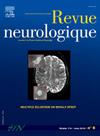Epileptic seizures recorded with microelectrodes: A persistent multiscale gap between neuronal activity, micro-, and macro-LFP?
IF 2.3
4区 医学
Q2 CLINICAL NEUROLOGY
引用次数: 0
Abstract
The cascade of events that occur in the human brain, from neurons to local circuits and global network dynamics during epileptic seizures, is barely understood. Ictogenesis in humans has been described in relation to electrophysiological concepts based on local field potentials (LFP) recorded by standard macroelectrodes (macro-LFP). Microelectrodes, however, record at the cellular scale. Despite over four decades of such recordings in patients with epilepsy, there remains a significant gap between these scales. This narrative review explores the contribution of microelectrode recordings of seizures in humans. By focusing closely on neuronal activity, researchers often overlook that microelectrodes also allow recording LFP at the micro-electrode level (micro-LFP). Above all, there is a gap between local circuits recorded at the micro-LFP level and large-scale network dynamics at the macro-LFP level, with little theoretical work to reconcile these two scales. Consequently, to date, analyses of seizures have been coarse, incomplete, and based on small numbers of patients. In particular, most multiscale seizure analyses have not included all three levels of scales (single units, micro-LFP, and macro-LFP) simultaneously, but doing so is key to providing a synthesis of ictal genesis. This review highlights the various challenges that face researchers using microelectrodes: (1) carrying out a systematic descriptive and quantitative analysis of the micro-LFP seizure signal, (2) improving the spatial correspondence between micro- and macroelectrodes in order to achieve better comparability between the two scales, (3) improving brain sampling thanks to specific devices, in particular deep electrodes with microwires, (4) reporting the reference electrode used in each study and how it may impact the results, (5) long duration of recordings over hours and days, and (6) shared simultaneous micro-LFP/macro-LFP databases.
微电极记录的癫痫发作:神经元活动、微观和宏观lfp之间的持续多尺度差距?
在癫痫发作期间,从神经元到局部电路和全球网络动态,人类大脑中发生的级联事件几乎不为人所知。人类的Ictogenesis已经被描述为基于由标准大电极(macro-LFP)记录的局部场电位(LFP)的电生理学概念。然而,微电极在细胞尺度上记录。尽管在癫痫患者中已有40多年的此类记录,但这些量表之间仍然存在显着差距。这篇叙述性综述探讨了人类癫痫发作的微电极记录的贡献。通过密切关注神经元活动,研究人员经常忽略了微电极也允许在微电极水平(micro-LFP)记录LFP。最重要的是,在微观lfp水平上记录的局部电路与宏观lfp水平上记录的大规模网络动态之间存在差距,很少有理论工作来调和这两个尺度。因此,到目前为止,对癫痫发作的分析是粗糙的,不完整的,并且基于少数患者。特别是,大多数多尺度癫痫分析并没有同时包括所有三个层次的尺度(单个单位、微观lfp和宏观lfp),但这样做是提供癫痫发生综合的关键。这篇综述强调了使用微电极的研究人员面临的各种挑战:(1)对微lfp发作信号进行系统的描述和定量分析;(2)改善微观和宏观电极之间的空间对应关系,以便在两个尺度之间实现更好的可比性;(3)由于特定设备,特别是带有微丝的深层电极,改善了大脑采样;(4)报告每项研究中使用的参考电极及其对结果的影响;(5)记录时间长达数小时和数天;(6)同时共享微观/宏观lfp数据库。
本文章由计算机程序翻译,如有差异,请以英文原文为准。
求助全文
约1分钟内获得全文
求助全文
来源期刊

Revue neurologique
医学-临床神经学
CiteScore
4.80
自引率
0.00%
发文量
598
审稿时长
55 days
期刊介绍:
The first issue of the Revue Neurologique, featuring an original article by Jean-Martin Charcot, was published on February 28th, 1893. Six years later, the French Society of Neurology (SFN) adopted this journal as its official publication in the year of its foundation, 1899.
The Revue Neurologique was published throughout the 20th century without interruption and is indexed in all international databases (including Current Contents, Pubmed, Scopus). Ten annual issues provide original peer-reviewed clinical and research articles, and review articles giving up-to-date insights in all areas of neurology. The Revue Neurologique also publishes guidelines and recommendations.
The Revue Neurologique publishes original articles, brief reports, general reviews, editorials, and letters to the editor as well as correspondence concerning articles previously published in the journal in the correspondence column.
 求助内容:
求助内容: 应助结果提醒方式:
应助结果提醒方式:


